1998 TOYOTA SUPRA tire size
[x] Cancel search: tire sizePage 28 of 191
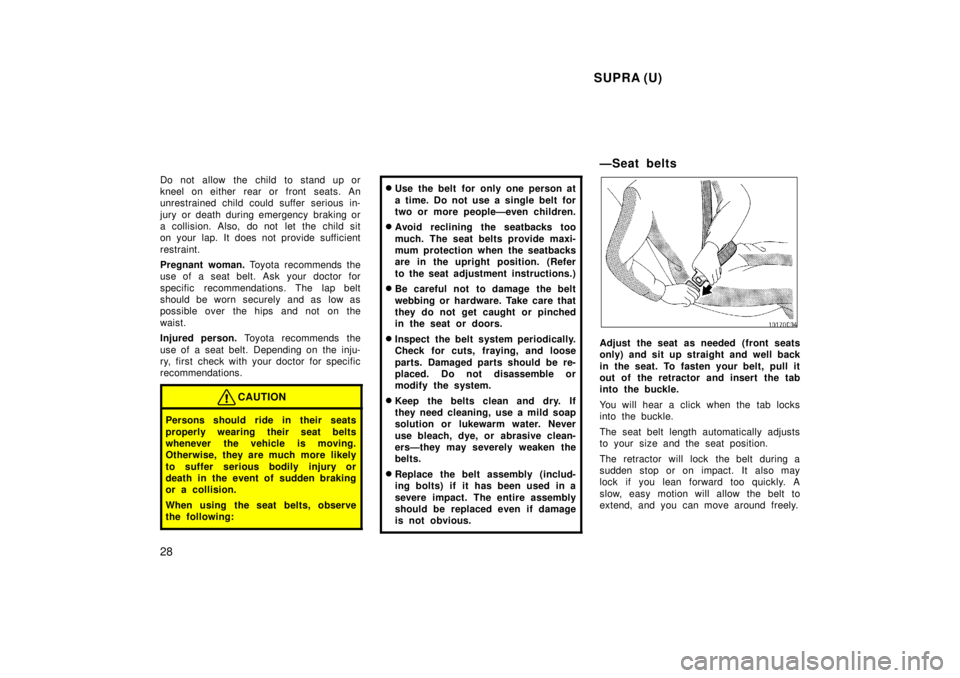
SUPRA (U)
28
Do not allow the child to stand up or
kneel on either rear or front seats. An
unrestrained child could suffer serious in-
jury or death during emergency braking or
a collision. Also, do not let the child sit
on your lap. It does not provide sufficient
restraint.
Pregnant woman.
Toyota recommends the
use of a seat belt. Ask your doctor for
specific recommendations. The lap belt
should be worn securely and as low as
possible over the hips and not on the
waist.
Injured person. Toyota recommends the
use of a seat belt. Depending on the inju-
ry, first check with your doctor for specific
recommendations.
CAUTION
Persons should ride in their seats
properly wearing their seat belts
whenever the vehicle is moving.
Otherwise, they are much more likely
to suffer serious bodily injury or
death in the event of sudden braking
or a collision.
When using the seat belts, observe
the following:
� Use the belt for only one person at
a time. Do not use a single belt for
two or more peopleÐeven children.
� Avoid reclining the seatbacks too
much. The seat belts provide maxi-
mum protection when the seatbacks
are in the upright position. (Refer
to the seat adjustment instructions.)
� Be careful not to damage the belt
webbing or hardware. Take care that
they do not get caught or pinched
in the seat or doors.
� Inspect the belt system periodically.
Check for cuts, fraying, and loose
parts. Damaged parts should be re-
placed. Do not disassemble or
modify the system.
� Keep the belts clean and dry. If
they need cleaning, use a mild soap
solution or lukewarm water. Never
use bleach, dye, or abrasive clean-
ersÐthey may severely weaken the
belts.
� Replace the belt assembly (includ-
ing bolts) if it has been used in a
severe impact. The entire assembly
should be replaced even if damage
is not obvious.
ÐSeat belts
Adjust the seat as needed (front seats
only) and sit up straight and well back
in the seat. To fasten your belt, pull it
out of the retractor and insert the tab
into the buckle.
You will hear a click when the tab locks
into the buckle.
The seat belt length automatically adjusts
to your size and the seat position.
The retractor will lock the belt during a
sudden stop or on impact. It also may
lock if you lean forward too quickly. A
slow, easy motion will allow the belt to
extend, and you can move around freely.
Page 105 of 191
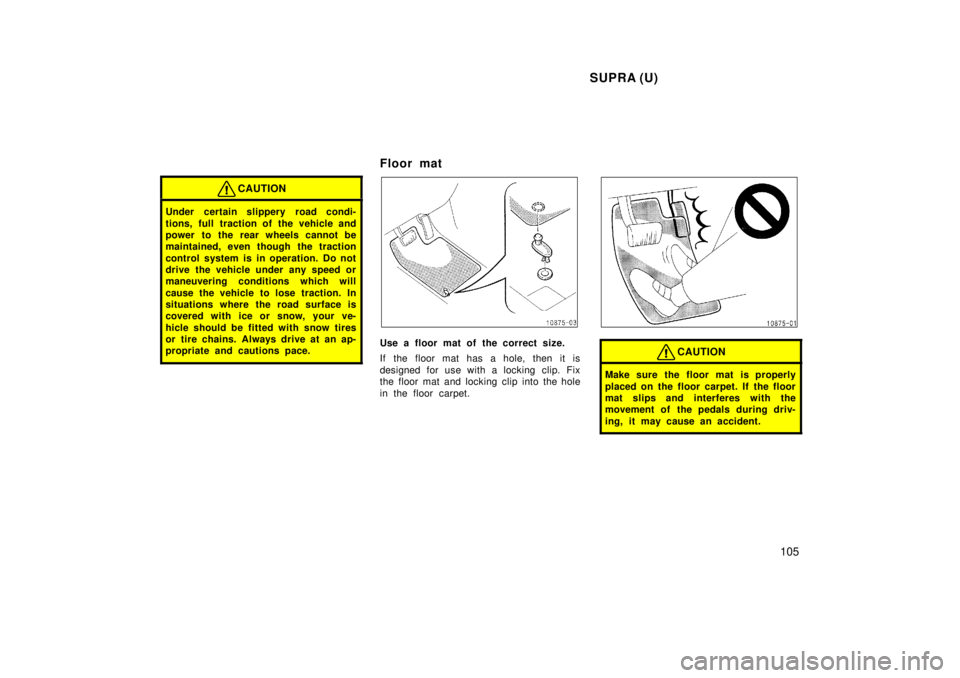
SUPRA (U)105
CAUTION
Under certain slippery road condi-
tions, full traction of the vehicle and
power to the rear wheels cannot be
maintained, even though the traction
control system is in operation. Do not
drive the vehicle under any speed or
maneuvering conditions which will
cause the vehicle to lose traction. In
situations where the road surface is
covered with ice or snow, your ve-
hicle should be fitted with snow tires
or tire chains. Always drive at an ap-
propriate and cautions pace.
Floor mat
Use a floor mat of the correct size.
If the floor mat has a hole, then it is
designed for use with a locking clip. Fix
the floor mat and locking clip into the hole
in the floor carpet.CAUTION
Make sure the floor mat is properly
placed on the floor carpet. If the floor
mat slips and interferes with the
movement of the pedals during driv-
ing, it may cause an accident.
Page 116 of 191

SUPRA (U)
11 6
Limited- slip differential
Some Toyotas are equipped with a lim-
ited- slip differential. If one rear wheel be-
gins to spin, the limited- slip differential is
designed to aid traction by automatically
transmitting driving force to the other rear
wheel. If you are not sure whether your
vehicle is equipped with one, you can ask
your Toyota dealer.
CAUTION
Do not start or run the engine while
your vehicle is supported by a jack.
The vehicle could be driven off the
jack and could pose a danger or re-
sult in serious injury.
NOTICE
Use only a spare tire of the same
size, construction and load capacityas the original tires on your Toyotabecause damage to the limited- slip
differential could possibly occur withanother tire type.
Your Toyota's identification
The vehicle identification number (VIN)
is the legal identifier for your vehicle.
This number is on the left top of the
instrument panel, and can be seen
through the windshield from outside.
The vehicle identification number (VIN) is
also on the Certification Label.
This is the primary identification number
for your Toyota. It is used in registering
the ownership of your vehicle.
Page 118 of 191
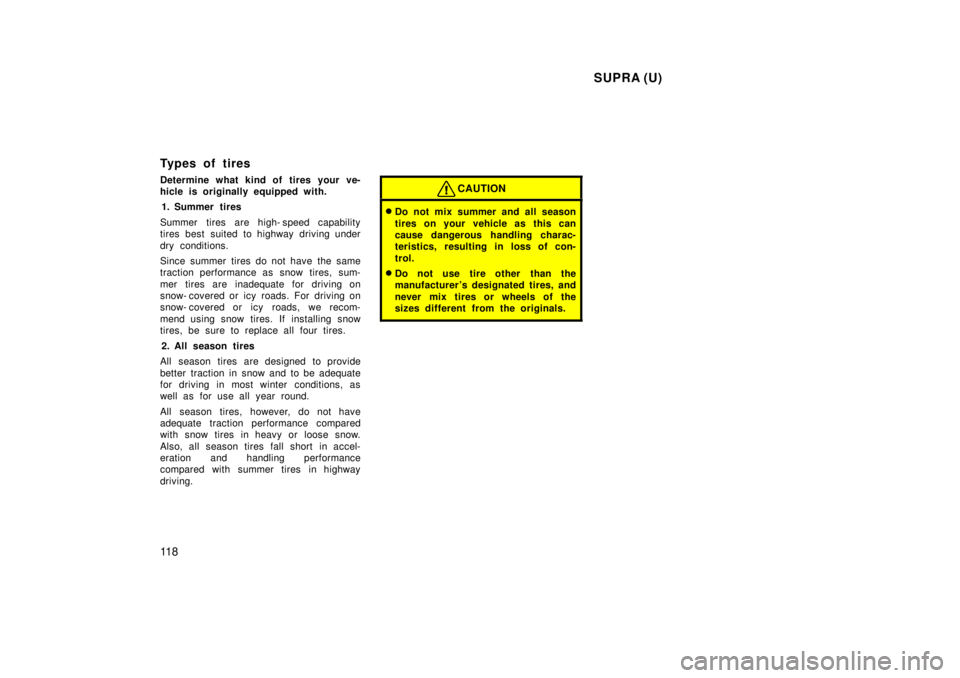
SUPRA (U)
11 8
Types of tires
Determine what kind of tires your ve-
hicle is originally equipped with.
1. Summer tires
Summer tires are high- speed capab ility
tires best suited to highway driving under
dry conditions.
Since summer tires do not have the same
traction performance as snow tires, sum-
mer tires are inadequate for driving on
snow- covered or icy roads. For driving on
snow- covered or icy roads, we recom-
mend using snow tires. If installing snow
tires, be sure to replace all four tires.
2. All season tires
All season tires are designed to provide
better traction in snow and to be adequate
for driving in most winter conditions, as
well as for use all year round.
All season tires, however, do not have
adequate traction performance compared
with snow tires in heavy or loose snow.
Also, all season tires fall short in accel-
eration and handling performance
compared with summer tires in highway
driving.
CAUTION
� Do not mix summer and all season
tires on your vehicle as this can
cause dangerous handling charac-
teristics, resulting in loss of con-
trol.
� Do not use tire other than the
manufacturer 's designated tires, and
never mix tires or wheels of the
sizes different from the originals.
Page 164 of 191
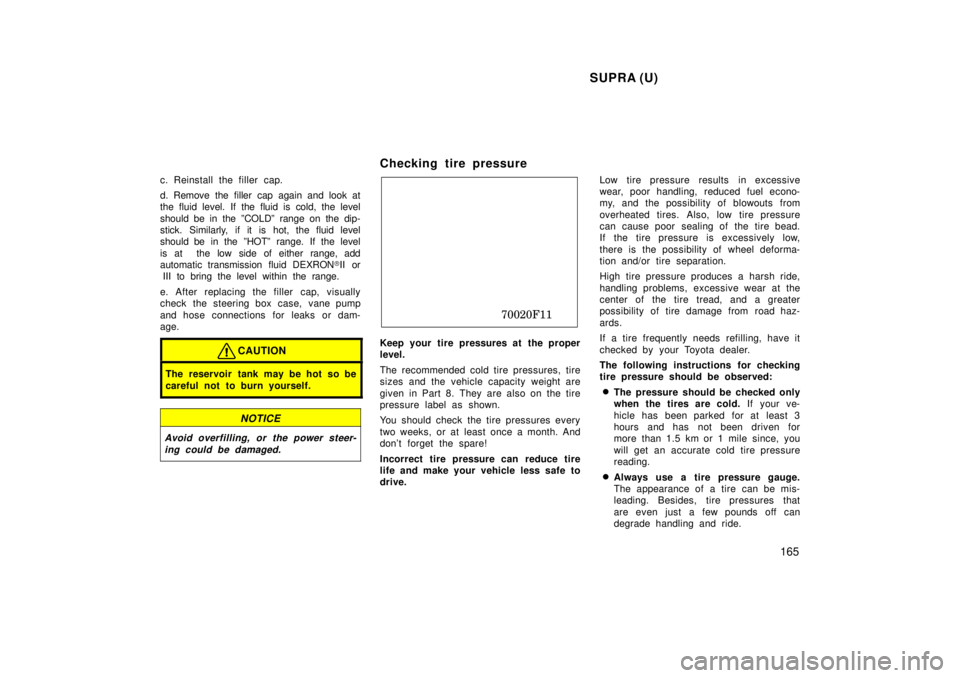
SUPRA (U)165
c. Reinstall the filler cap.
d. Remove the filler cap again and look at
the fluid level. If the fluid is cold, the level should be in the ºCOLDº range on the dip-
stick. Similarly, if it is hot, the fluid level
should be in the ºHOTº range. If the level
is at the low side of either range, add
automatic transmission fluid DEXRON
�II or
III to bring the level within the range.
e. After replacing the filler cap, visually
check the steering box case, vane pump
and hose connections for leaks or dam- age.
CAUTION
The reservoir tank may be hot so be
careful not to burn yourself.
NOTICE
Avoid overfilling, or the power steer- ing could be damaged.
Checking tire pressure
70020F11
Keep your tire pressures at the proper
level.
The recommended cold tire pressures, tire
sizes and the vehicle capacity weight are
given in Part 8. They are also on the tire
pressure label as shown.
You should check the tire pressures every
two weeks, or at least once a month. And
don't forget the spare!
Incorrect tire pressure can reduce tire
life and make your vehicle less safe to
drive. Low tire pressure results in excessive
wear, poor handling, reduced fuel econo-
my, and the possibility of blowouts from
overheated tires. Also, low tire pressure
can cause poor sealing of the tire bead.
If the tire pressure is excessively low,
there is the possibility of w
heel deforma-
tion and/or tire separation.
High tire pressure produces a harsh ride,
handling problems, excessive wear at the
center of the tire tread, and a greater
possibility of tire damage from road haz-
ards.
If a tire frequently needs ref illing, have it
checked by your Toyota dealer.
The following instructions for checking
tire pressure should be observed:
� The pressure should be checked only
when the tires are cold. If your ve-
hicle has been parked for at least 3
hours and has not been driven for
more than 1.5 km or 1 mile since, you
will get an accurate cold tire pressure
reading.
� Always use a tire pressure gauge.
The appearance of a tire can be mis-
leading. Besides, tire pressures that
are even just a few pounds off can
degrade handling and ride.
Page 165 of 191

SUPRA (U)
166 �
Take special care when adding air to
the compact spare tire. The smaller
tire size can gain pressure very quick-
ly. Add compressed air in small quanti-
ties and check the pressure often until
it reaches the specified pressure.
� Do not bleed or reduce tire pressure
after driving. It is normal for the tire
pressure to be higher after driving.
� Never exceed the vehicle capacity
weight. The passenger and luggage
weight should be located so that the
vehicle is balanced.
� Be sure to reinstall the tire inflation
valve caps. Without the valve caps,
dirt or moisture could get into the valve
core and cause air leakage. If the caps
have been lost, have new ones put on
as soon as possible. Checking and replacing tires
70040F01
CHECKING YOUR TIRES
Check the tire tread for the tread wear
indicators. If the indicators show, re-
place the tires.
The tires on your Toyota have built- in
tread wear indicators to help you know
when the tires need replacement. When
the tread depth wears to 1.6 mm (0.06
in.) or less, the indicators will appear. If
you can see the indicators in two or more
adjacent grooves, the tire should be re-
placed. The lower the tread, the higher
the risk of skidding. Your Supra has been fitted with specially
developed tires which provide exceptional
dynamic performance under general road
conditions. However you may also notice
that your tires will wear more rapidly and
tire grip performance will be reduced on
the snowy and/or icy roads when
compared to standard tires. Be sure to
have snow tires or tire chains on the
snowy and/or icy roads and drive carefully
with speed appropriate for road conditions.
The effectiveness of snow tires is lost
if the tread wears down below 4 mm
(0.16 in.).
Check the tires regularly for damage
such as cuts, splits and cracks. If any
damage is found, consult with a techni-
cian and have the tire repaired or re-
placed.
Even if the damage does not appear seri-
ous, a qualified technician should examine
the damage. Objects which have pene-
trated the tire may have caused internal
damage.
Any tires which are over six years old
must be checked by a qualified techni-
cian even if damage is not obvious.
Tires deteriorate with age even if they
have never or seldom been used.
Page 166 of 191

SUPRA (U)167
This also applies to the spare tire and
tires stored for future use.
REPLACING YOUR TIRES
When replacing a tire, use only the
same size and construction as original-
ly installed and with the same or great-
er load capacity.
Using any other size or type of tire may
seriously affect handling, ride, speedome-
ter/odometer calibration, ground clearance,
and clearance between the body and tires
or snow chains.
CAUTION
�
Do not mix radial, bias belted, or
bias- ply tires on your vehicle. It
can cause dangerous handling char-
acteristics, resulting in loss of con-
trol.
� Do not use tires or wheels other
than the manufacturer 's recom-
mended size.
Toyota recommends all four tires, or at
least both of the front or rear tires be
replaced at a time as a set.
See ºIf you have a flat tireº in Part 4 for
tire change procedure. When a tire is replaced, the wheel
should always be balanced.
An unbalanced wheel may affect vehicle
handling and tire life. Wheels can get out
of balance with regular use and should
therefore be balanced occasionally.
When replacing a tubeless tire, the air
valve should also be replaced with a
new one.
Rotating tires
70030F08
Do not perform rotation of the tires,
from front to rear or from left to right,
or using the compact spare tire. Per-
forming such tire rotation may result in
the tires interfering with the body or in
uneven wear of the tires, so that steer-
ability of the vehicle is impaired.
Tires with turning direction indicatorÐ
The tire is a uni- directional type and can-
not be used for tire rotation. Using the tire
on the opposite side to the designated
side will impair the tire performance.
The compact spare tireÐ
The tire is designed for temporary use
only and cannot be used for tire rotation.
Page 167 of 191
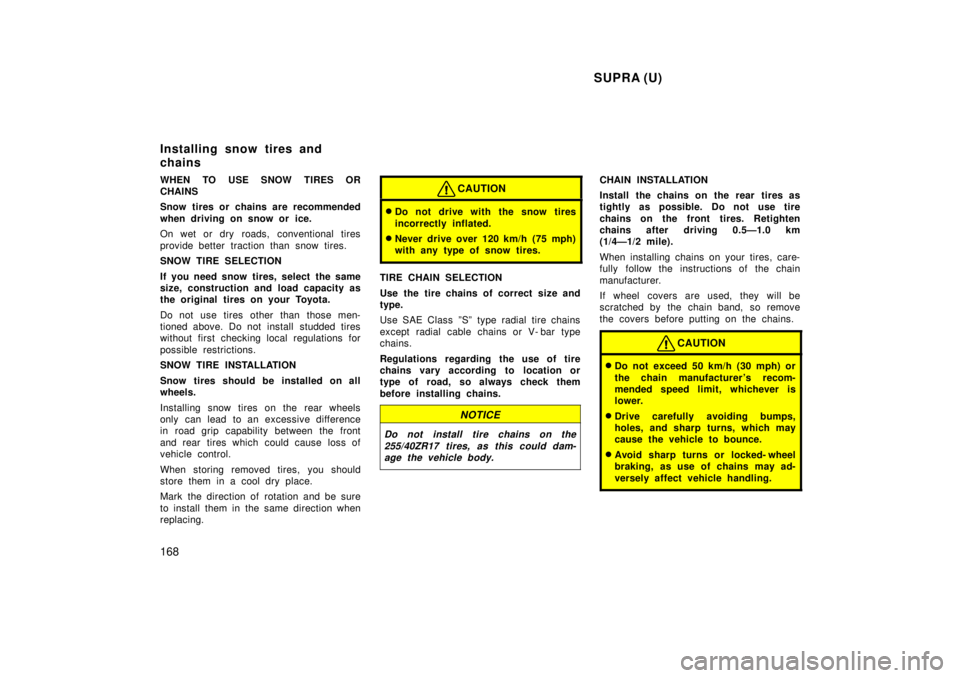
SUPRA (U)
168
WHEN TO USE SNOW TIRES OR
CHAINS
Snow tires or chains are recommended
when driving on snow or ice.
On wet or dry roads, conventional tires
provide better traction than snow tires.
SNOW TIRE SELECTION
If you need snow tires, select the same
size, construction and load capacity as
the original tires on your Toyota.
Do not use tires other than those men-
tioned above. Do not install studded tires
without first checking local regulations for
possible restrictions.
SNOW TIRE INSTALLATION
Snow tires should be installed on all
wheels.
Installing snow tires on the rear w
heels
only can lead to an excessive difference
in road grip capab ility between the front
and rear tires which could cause loss of
vehicle control.
When storing removed tires, you should
store them in a cool dry place.
Mark the direction of rotation and be sure
to install them in the same direction when
replacing.
CAUTION
� Do not drive with the snow tires
incorrectly inflated.
� Never drive over 120 km/h (75 mph)
with any type of snow tires.
TIRE CHAIN SELECTION
Use the tire chains of correct size and
type.
Use SAE Class ºSº type radial tire chains
except radial cable chains or V- bar type
chains.
Regulations regarding the use of tire
chains vary according to location or
type of road, so always check them
before installing chains.
NOTICE
Do not install tire chains on the
255/40ZR17 tires, as this could dam-age the vehicle body.
CHAIN INSTALLATION
Install the chains on the rear tires as
tightly as possible. Do not use tire
chains on the front tires. Retighten
chains after driving 0.5Ð1.0 km
(1/4Ð1/2 mile).
When installing chains on your tires, care-
fully follow the instructions of the chain
manufacturer.
If wheel covers are used, they will be
scratched by the chain band, so remove
the covers before putting on the chains.
CAUTION
� Do not exceed 50 km/h (30 mph) or
the chain manufacturer 's recom-
mended speed limit, whichever is
lower.
� Drive carefully avoiding bumps,
holes, and sharp turns, which may
cause the vehicle to bounce.
� Avoid sharp turns or locked- wheel
braking, as use of chains may ad-
versely affect vehicle handling.
Installing snow tires and
chains